Related Research Articles
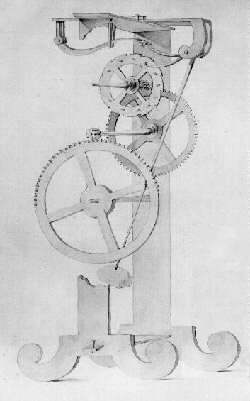
A pendulum clock is a clock that uses a pendulum, a swinging weight, as its timekeeping element. The advantage of a pendulum for timekeeping is that it is an approximate harmonic oscillator: It swings back and forth in a precise time interval dependent on its length, and resists swinging at other rates. From its invention in 1656 by Christiaan Huygens, inspired by Galileo Galilei, until the 1930s, the pendulum clock was the world's most precise timekeeper, accounting for its widespread use. Throughout the 18th and 19th centuries, pendulum clocks in homes, factories, offices, and railroad stations served as primary time standards for scheduling daily life, work shifts, and public transportation. Their greater accuracy allowed for the faster pace of life which was necessary for the Industrial Revolution. The home pendulum clock was replaced by less-expensive synchronous electric clocks in the 1930s and '40s. Pendulum clocks are now kept mostly for their decorative and antique value.

Christiaan Huygens, Lord of Zeelhem, was a Dutch mathematician, physicist, engineer, astronomer, and inventor who is regarded as a key figure in the Scientific Revolution. In physics, Huygens made seminal contributions to optics and mechanics, while as an astronomer he studied the rings of Saturn and discovered its largest moon, Titan. As an engineer and inventor, he improved the design of telescopes and invented the pendulum clock, the most accurate timekeeper for almost 300 years. A talented mathematician and physicist, his works contain the first idealization of a physical problem by a set of mathematical parameters, and the first mathematical and mechanistic explanation of an unobservable physical phenomenon.

A pendulum is a device made of a weight suspended from a pivot so that it can swing freely. When a pendulum is displaced sideways from its resting, equilibrium position, it is subject to a restoring force due to gravity that will accelerate it back toward the equilibrium position. When released, the restoring force acting on the pendulum's mass causes it to oscillate about the equilibrium position, swinging back and forth. The time for one complete cycle, a left swing and a right swing, is called the period. The period depends on the length of the pendulum and also to a slight degree on the amplitude, the width of the pendulum's swing.
The hypothetico-deductive model or method is a proposed description of the scientific method. According to it, scientific inquiry proceeds by formulating a hypothesis in a form that can be falsifiable, using a test on observable data where the outcome is not yet known. A test outcome that could have and does run contrary to predictions of the hypothesis is taken as a falsification of the hypothesis. A test outcome that could have, but does not run contrary to the hypothesis corroborates the theory. It is then proposed to compare the explanatory value of competing hypotheses by testing how stringently they are corroborated by their predictions.
The year 1715 in science and technology involved some significant events.
The year 1704 in science and technology involved some significant events.
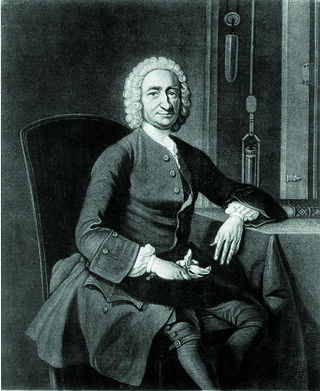
George Graham, FRS was an English clockmaker, inventor, and geophysicist, and a Fellow of the Royal Society.

An escapement is a mechanical linkage in mechanical watches and clocks that gives impulses to the timekeeping element and periodically releases the gear train to move forward, advancing the clock's hands. The impulse action transfers energy to the clock's timekeeping element to replace the energy lost to friction during its cycle and keep the timekeeper oscillating. The escapement is driven by force from a coiled spring or a suspended weight, transmitted through the timepiece's gear train. Each swing of the pendulum or balance wheel releases a tooth of the escapement's escape wheel, allowing the clock's gear train to advance or "escape" by a fixed amount. This regular periodic advancement moves the clock's hands forward at a steady rate. At the same time, the tooth gives the timekeeping element a push, before another tooth catches on the escapement's pallet, returning the escapement to its "locked" state. The sudden stopping of the escapement's tooth is what generates the characteristic "ticking" sound heard in operating mechanical clocks and watches.

In horology, the anchor escapement is a type of escapement used in pendulum clocks. The escapement is a mechanism in a mechanical clock that maintains the swing of the pendulum by giving it a small push each swing, and allows the clock's wheels to advance a fixed amount with each swing, moving the clock's hands forward. The anchor escapement was so named because one of its principal parts is shaped vaguely like a ship's anchor.

The vergeescapement is the earliest known type of mechanical escapement, the mechanism in a mechanical clock that controls its rate by allowing the gear train to advance at regular intervals or 'ticks'. Verge escapements were used from the late 13th century until the mid 19th century in clocks and pocketwatches. The name verge comes from the Latin virga, meaning stick or rod.
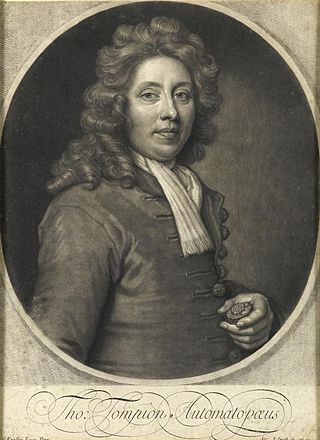
Thomas Tompion, FRS (1639–1713) was an English clockmaker, watchmaker and mechanician who is still regarded to this day as the "Father of English Clockmaking". Tompion's work includes some of the most historic and important clocks and watches in the world, and can command very high prices whenever outstanding examples appear at auction. A plaque commemorates the house he shared on Fleet Street in London with his equally famous pupil and successor George Graham.

Galileo's escapement is a design for a clock escapement, invented around 1637 by Italian scientist Galileo Galilei (1564–1642). Galileo was one of the leading minds of the Scientific Revolution. He was dubbed the founder of theoretical physics. He is also credited with the invention of the celatone and the geometric and military compass. Galileo's escapement was the earliest design of a pendulum clock. Since Galileo was by then blind, he described the device to his son Vincenzio, who drew a sketch of it. The son began construction of a prototype, but both he and Galileo died before it was completed.
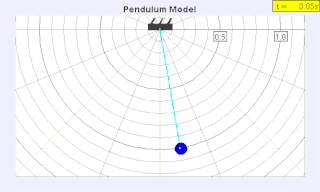
A seconds pendulum is a pendulum whose period is precisely two seconds; one second for a swing in one direction and one second for the return swing, a frequency of 0.5 Hz.

A turret clock or tower clock is a clock designed to be mounted high in the wall of a building, usually in a clock tower, in public buildings such as churches, university buildings, and town halls. As a public amenity to enable the community to tell the time, it has a large face visible from far away, and often a striking mechanism which rings bells upon the hours.

Salomon Coster was a Dutch clockmaker of the Hague, who in 1657 was the first to make a pendulum clock, which had been invented by Dutch mathematician Christiaan Huygens (1629-1695). Coster died a sudden death in 1659.

A marine chronometer is a precision timepiece that is carried on a ship and employed in the determination of the ship's position by celestial navigation. It is used to determine longitude by comparing Greenwich Mean Time (GMT), and the time at the current location found from observations of celestial bodies. When first developed in the 18th century, it was a major technical achievement, as accurate knowledge of the time over a long sea voyage was vital for effective navigation, lacking electronic or communications aids. The first true chronometer was the life work of one man, John Harrison, spanning 31 years of persistent experimentation and testing that revolutionized naval navigation.

The history of timekeeping devices dates back to when ancient civilizations first observed astronomical bodies as they moved across the sky. Devices and methods for keeping time have gradually improved through a series of new inventions, starting with measuring time by continuous processes, such as the flow of liquid in water clocks, to mechanical clocks, and eventually repetitive, oscillatory processes, such as the swing of pendulums. Oscillating timekeepers are used in modern timepieces.
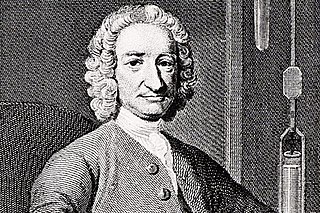
Daniel Quare was an English clockmaker and instrument maker who invented a repeating watch movement in 1680 and a portable barometer in 1695.

Horologium Oscillatorium: Sive de Motu Pendulorum ad Horologia Aptato Demonstrationes Geometricae is a book published by Dutch mathematician and physicist Christiaan Huygens in 1673 and his major work on pendula and horology. It is regarded as one of the three most important works on mechanics in the 17th century, the other two being Galileo’s Discourses and Mathematical Demonstrations Relating to Two New Sciences (1638) and Newton’s Philosophiæ Naturalis Principia Mathematica (1687).
References
- ↑ "I believe that we do not know anything for certain, but everything probably." —Christiaan Huygens, Letter to Pierre Perrault, 'Sur la préface de M. Perrault de son traité del'Origine des fontaines' [1763], Oeuvres Complétes de Christiaan Huygens (1897), Vol. 7, 298. Quoted in Jacques Roger, The Life Sciences in Eighteenth-Century French Thought, ed. Keith R. Benson and trans. Robert Ellrich (1997), 163. Quotation selected by W.F. Bynum and Roy Porter (eds., 2005), Oxford Dictionary of Scientific Quotations ISBN 0-19-858409-1 p. 317 quotation 4.
- ↑ Gullberg, Jan. Mathematics from the Birth of Numbers. W. W. Norton & Company. pp. 963–965. ISBN 978-0-393-04002-9.
- ↑ "The Coffee Houses of Old London". Archived from the original on 2012-02-25. Retrieved 2011-05-23.
- ↑ Morrice, J. C. (1918). Wales in the Seventeenth Century: its literature and men of letters and action. Bangor: Jarvis & Foster. p. 26. Retrieved 2011-05-23.
- ↑ van den Ende, Hans; et al. (2004). Huygens's Legacy: The Golden Age of the Pendulum Clock. Fromanteel Ltd.
- ↑ Milham, Willis I. (1945). Time and Timekeepers. London: Macmillan. p. 146. ISBN 978-0-7808-0008-3.
- ↑ Glasgow, David (1885). Watch and Clock Making. London: Cassell. p. 293.
- ↑ Headrick, Michael (2002). "Origin and Evolution of the Anchor Clock Escapement". Control Systems Magazine. 22 (2). Institute of Electrical and Electronics Engineers. Archived from the original on October 25, 2009. Retrieved 2007-06-06.
- ↑ Reid, Thomas (1832). Treatise on Clock and Watch-making, Theoretical and Practical. Philadelphia: Carey & Lea. p. 184.
- ↑ Panzanelli, Roberta (2008). Ephemeral Bodies:Wax Sculpture and the Human Figure. Getty Research Institute. p. 102. ISBN 9780892368778.